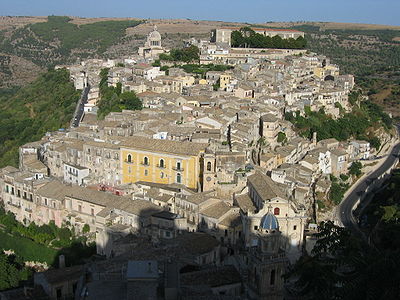RAGUSA
Close to Modica, in the Northern
part of Sicily, is where you’ll find Ragusa, a City
with ancient origins and a main town furthest South of Italy.
Its territory, in the hilly part of Ibla, results as inhabited
since the III Century BC, as demonstrated by finds and by
the Necropolises and furnaces from a successive age (8th Century
BC), but however, pre-Hellenistic.
With the arrival of the Greeks and Siculi, settlements pushed
further inland and saw the founding of Hybla Heraia.
It subsequently fell under Greek scrutiny and was witness
to a clash between the Carthaginians and Syracusans (5th and
4th Century BC), until the arrival of the Romans (3rd Century
BC).
After the end of the Roman empire, successive Goth and Vandali
invasions and the period of the Ostrogoth Reign, concluding
with the Greek-Gothic War of 535, Ragusa passed hands to the
Byzantines, who fortified it. The same Byzantines also initiated
construction of the defensive castle.
It was conquered by the Arabs in 848 and remained under their
dominion until the Norman conquest of Sicily. In 1091, the
City was assigned to Goffredo d’Altavilla, illegitimate
son of Count Ruggero, and took on a Medieval appearance, which
can still be recognised today in some areas of Ragusa.
After the Swabians and the Angioina period, Ragusa passed
under rule of the Chiaramonte Family in 1296, under which
it was unified to the County of Modica.
In the 15th Century, under the management of the Cabrera,
Ragusa enjoyed a period of economic and social development.
Ragusa lost its Castle and a great part of its architectonic
patrimony with the earthquake of 1693. The City moved down
from the hills to allow expansion in the modern day area of
Corso Italia. An expansion which then moved to such an extent
towards higher areas during the 14th and 20th Centuries, that
for some years the City was divided into two different communes
(1865).
When visiting the City, the following are recommended: the
Ibleo Regional Archaeological Museum which hosts an important
collection of ancient finds for different eras: Pre-Historic,
Sicula, Greek and Roman.
Nearby, it’s possible to visit the Cathedral of Saint
John the Baptist (18th Century) and S. Maria delle Scale,
which connects the two cities like the great bridges connecting
Ragusa Superiore (Upper Town) to the Inferiore (Lower Town).
One can therefore then visit the Duomo of S. Giorgio (1738)
with its Neo-Classical dome.
|
